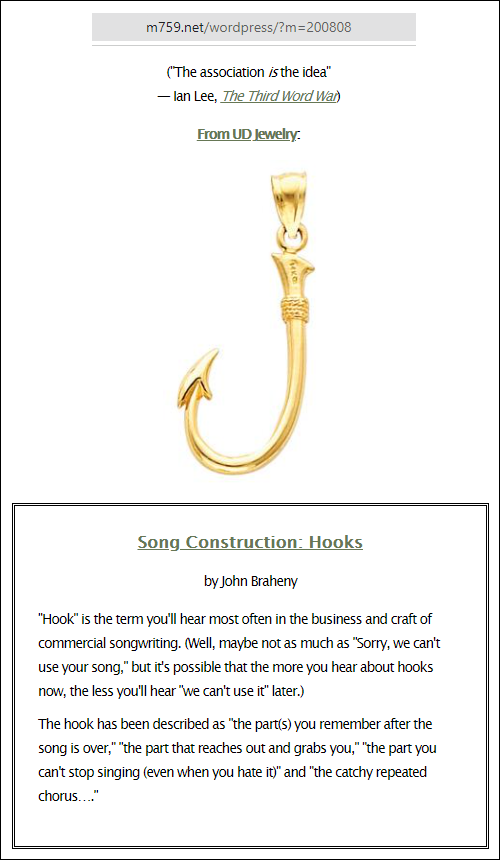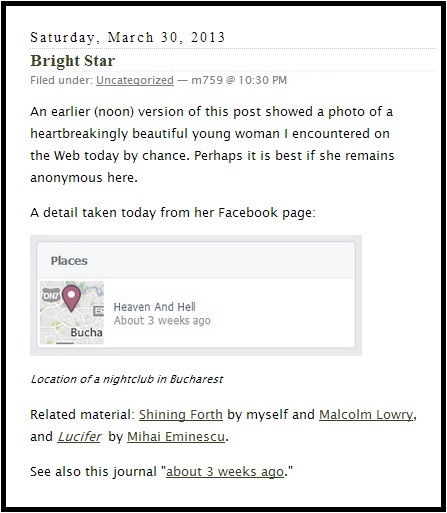
Friday, July 26, 2013
The Zero Theorem
Saturday, October 23, 2021
Deep Six
From a Thursday morning, Oct. 21, Instagram post —
Related cinematic meditation —
The above scene is from Babylon A.D. (August 2008).
Related question from an early edition of Trivial Pursuit —
"Does Uranus have an aurora?"
Related drama for Brechtians — Branded , The Zero Theorem ,
and, from my own efforts of August 2008 . . .

Monday, March 9, 2020
The Bucharest Cross
For fans of "The Zero Theorem" —
The 24 permutations of S4 arranged on a cube
by Cristi Stoica of Bucharest at
http://www.unitaryflow.com/2009/06/polyhedra-and-groups.html:
Sunday, September 17, 2017
Scholium
"My guess is you're looking for
the least, little entity."
— Subtitle in "The Zero Theorem"
from the previous post.
Related material —
See as well some purely mathematical properties of a byte
discussed here on July 7, 2011.
Saturday, September 16, 2017
The Zero Monstrance
From "The Metaphysics of Entities," a post of Sept. 20, 2014 —
Anthony Lane in The New Yorker on a 2013 film —
"The hero of 'The Zero Theorem' is a computer genius
called Qohen Leth (Christoph Waltz)…. He is the sole
resident of a derelict church, where, on a crucifix in front
of the altar, the head of Christ has been replaced by a
security camera. No prayers are ever said, and none are
answered."
Related dialogue from a 2008 film —
Another view of the Zero Theorem derelict church —
Thursday, September 14, 2017
Found …
( A sequel to the previous post, Lost )
From a link, "A Little Boy and a Little Girl," found in a Log24
search for Andersen + Atlantic —
"A few flakes of snow were falling, and one of them, rather larger
than the rest, alighted on the edge of one of the flower boxes.
This snow-flake grew larger and larger, till at last it became
the figure of a woman, dressed in garments of white gauze,
which looked like millions of starry snow-flakes linked together.
She was fair and beautiful, but made of ice—
shining and glittering ice." — "The Snow Queen"
Related material —
Analogue of the little boy from "The Snow Queen" in "Equals" (2015) —

"Nice piece of ice." — Brendan Fraser in
"The Mummy: Tomb of the Dragon Emperor" (2008).
See also the concept that everything adds up to nothing in
"The Zero Theorem" (2013) …
… and the Conway-Norton-Ryba theorem (2017).
Wednesday, June 7, 2017
Development Hell
Two readings —
On the director of "The Zero Theorem" —
Terry Gilliam Finally Wraps on ‘Don Quixote’ Film After 17 Years.
More seriously —
On a Spanish author who reportedly died at 86 on Sunday, June 4.

Thursday, April 20, 2017
Point Zero
Monday, December 26, 2016
For What It’s Worth
The previous post introduced the phrase "secondary meaning."
A discussion —
" In order to establish a secondary meaning for a term,
a plaintiff 'must show that the primary significance in
the minds of the consuming public is not the product
but the producer.' "
— FreeAdvice®.com
See also The Zero Theorem and Bialystock in this journal.
Tuesday, March 22, 2016
The Zero Obit
Friday, December 18, 2015
Sequel
A prequel to the 2013 film "The Zero Theorem" —
"Down below, infinitely deep into the blackness,
things were beginning. The blackness had
arranged itself into a whirlpool…."
— Peter Dickinson, A Box of Nothing (1985),
"Chapter 19: Star Tree"
— may serve as a sequel to the life of the book's author.
(See Dickinson Sequel in this journal.)
Saturday, November 21, 2015
The Zero System
For the title phrase, see Encyclopedia of Mathematics .
The zero system illustrated in the previous post*
should not be confused with the cinematic Zero Theorem .
* More precisely, in the part showing the 15 lines fixed under
a zero-system polarity in PG(3,2). For the zero system
itself, see diamond-theorem correlation.
Monday, September 28, 2015
Intruders for Mira
Friday, July 3, 2015
Crunching Entities*

A figure I prefer to the "Golden Tablet" of Night at the Museum —
The source — The Log24 post "Zero System" of July 31, 2014.
* For the title, see The New Yorker of Sept. 22, 2014.
Monday, December 8, 2014
Language Game
Continued from December 5 .
The previous post dealt with video game pioneer Ralph Baer.
Here is a link in honor of mathematician Reinhold Baer
(see Baer in Zero System , a post from the feast of St. Ignatius
Loyola in 2014.)
The posts in Reinhold 's link (those tagged "Yankee Puzzle")
include a reference to the Zero System post. The link tag was
suggested in part by the devil's claws in yesterday morning's post
The Kernel Conundrum and in part by last night's
Kennedy Center Honors tribute to Tom Hanks.
Hanks as the Harvard "symbologist" from the
novels of Dan Brown —
Wednesday, November 19, 2014
The Eye/Mind Conflict
Harold Rosenberg, "Art and Words,"
The New Yorker , March 29, 1969. From page 110:
"An advanced painting of this century inevitably gives rise
in the spectator to a conflict between his eye and his mind;
as Thomas Hess has pointed out, the fable of the emperor's
new clothes is echoed at the birth of every modemist art
movement. If work in a new mode is to be accepted, the
eye/mind conflict must be resolved in favor of the mind;
that is, of the language absorbed into the work. Of itself,
the eye is incapable of breaking into the intellectual system
that today distinguishes between objects that are art and
those that are not. Given its primitive function of
discriminating among things in shopping centers and on
highways, the eye will recognize a Noland as a fabric
design, a Judd as a stack of metal bins— until the eye's
outrageous philistinism has been subdued by the drone of
formulas concerning breakthroughs in color, space, and
even optical perception (this, too, unseen by the eye, of
course). It is scarcely an exaggeration to say that paintings
are today apprehended with the ears. Miss Barbara Rose,
once a promoter of striped canvases and aluminum boxes,
confesses that words are essential to the art she favored
when she writes, 'Although the logic of minimal art gained
critical respect, if not admiration, its reductiveness allowed
for a relatively limited art experience.' Recent art criticism
has reversed earlier procedures: instead of deriving principles
from what it sees, it teaches the eye to 'see' principles; the
writings of one of America's influential critics often pivot on
the drama of how he failed to respond to a painting or
sculpture the first few times he saw it but, returning to the
work, penetrated the concept that made it significant and
was then able to appreciate it. To qualify as a member of the
art public, an individual must be tuned to the appropriate
verbal reverberations of objects in art galleries, and his
receptive mechanism must be constantly adjusted to oscillate
to new vocabularies."
New vocabulary illustrated:
Graphic Design and a Symplectic Polarity —

Background: The diamond theorem
and a zero system .
Saturday, September 20, 2014
The Metaphysics of Entities
Anthony Lane in The New Yorker , issue dated Sept. 22, 2014:
"The hero of 'The Zero Theorem' is a computer genius called Qohen Leth
(Christoph Waltz)…. He is the sole resident of a derelict church, where,
on a crucifix in front of the altar, the head of Christ has been replaced by
a security camera. No prayers are ever said, and none are answered.
In short, the place is deconsecrated, but to claim that it lacks any spark of
sacred yearning would be wrong, because Qohen devotes his days to seeking
the Zero Theorem, which—whatever it may be—lies at the fuzzy limit of
human powers. “We crunch entities,” he says, as if that explained anything.
His employer is Mancom, a large corporation that, in Orwellian fashion,
oversees ordinary lives, although it betrays more frantic desperation than
glowering threat."
One approach to the metaphysics of entities was indicated in the previous
post, 'Metaphysics for Gilliam." A different approach:
"Categories, Sets, and the Nature of Mathematical Entities,"
by Jean-Pierre Marquis, Ch. 13, pp. 181-192, in the 2006 book
The Age of Alternative Logics , ed. by van Benthem et al.
(Springer, Netherlands).
From pages 182-183 —
13.2 The nature of mathematical entities
Let us start with the nature of mathematical entities in general and with a
rough and classical distinction that will simply set the stage for the picture we
want to develop. We essentially follow Lowe 1998* for the basic distinctions. We
need to distinguish between abstract and concrete entities, on the one hand, and
universals and particulars on the other hand. For our purpose, it is not necessary
to specify a criterion of demarcation between abstract and concrete entities. We
simply assume that such a distinction can be made, e.g. concrete entities can
change whereas abstract entities cannot. We assume that a universal is an entity
that can be instantiated by entities which themselves are not instantiable, the
latter being of course particulars. Given these distinctions, an entity can be a
concrete particular, a concrete universal, an abstract particular or an abstract
universal.
Our focus here is between the last two possibilities. For we claim that the
current conception of sets makes them abstract particulars whereas for objects
defined within categories, mathematical entities are abstract universals. This,
we claim, is true of category theory as it is.
* Lowe, E.J., 1998, The Possibility of Metaphysics , Oxford: Clarendon Press.
Friday, September 19, 2014
Metaphysics for Gilliam
See also…

Related remarks: Diederik Aerts at arXiv.org.
See also Aerts (as above) on the metaphysics of entities (1984):

Thursday, July 31, 2014
Zero System
The title phrase (not to be confused with the film 'The Zero Theorem')
means, according to the Encyclopedia of Mathematics,
a null system , and
"A null system is also called null polarity,
a symplectic polarity or a symplectic correlation….
it is a polarity such that every point lies in its own
polar hyperplane."
See Reinhold Baer, "Null Systems in Projective Space,"
Bulletin of the American Mathematical Society, Vol. 51
(1945), pp. 903-906.
An example in PG(3,2), the projective 3-space over the
two-element Galois field GF(2):

See also the 10 AM ET post of Sunday, June 8, 2014, on this topic.
Tuesday, July 22, 2014
Sunday, February 9, 2014
Green Night
See “Babbled” in this journal and …
Update of 3:15 AM ET —
Suggestions for Terry Gilliam, director of The Zero Theorem and Brazil —
See posts of April 26, 2013, and of February 2, 2014, as well as
a note from the São Paulo Symphony Orchestra.
Thursday, December 12, 2013
Outsider
The late Colin Wilson appears at the head
of this afternoon's New York Times obituaries —
Margalit Fox's description this afternoon of
Wilson's first book, from 1956—
"The Outsider had an aim no less ambitious
than its scope: to delineate the meaning of
human existence."
This suggests a review of Log24 posts on "The Zero Theorem"
that yields—

See also Log24 on the date of Wilson's death.
Related material: Devil's Night, 2011.
Friday, November 1, 2013
Chapel
In memory of Anca Petrescu,
"the Albert Speer of Communism."
Source: www.thezerotheorem-movie.com.
The Gilliam quotes are from insidemovies.ew.com.
Thursday, September 5, 2013
An Effective Team:
Underworld and Evolution
This journal on 9/11, 2009 —
Poster for Kate Beckinsale in a film
released on 9/11, 2009 —
For Qohen Leth — A quotation from
this journal on 9/11, 2009 —
"Time and chance
happeneth to them all."
— Ecclesiastes 9:11
Thursday, August 29, 2013
An End in Itself
(Mathematics and Narrative, continued from May 9, 2013)

See also Scriba's The Concept of Number and,
from the date of his death, The Zero Theorem.
Wednesday, May 15, 2013
The Crying of Bucharest
From a reported interview with Terry Gilliam:
Question: "You said in an interview that The Zero Theorem
was very influenced by Bucharest. In what way?"
Some related material from Log24:
See also a Google search from this evening—

— and the beginning of the Zero Theorem screenplay —
FADE IN:
A rim of swirling light appears, circling helplessly into a
gigantic BLACK HOLE. It spirals inward…
Thursday, May 9, 2013
Mathematics and Narrative (continued)
"Why history?
Well, the essence of history is story ,
and a good story is an end in itself."
— Barry Mazur, "History of Mathematics as a tool,"
February 17, 2013
This journal on February 17, 2013:FROM Christoph Waltz"Currently in post-production": The Zero Theorem. For Christoph WaltzRaiders of the Lost Tesseract continues… SOCRATES: Is he not better off in knowing his ignorance? |

See also today's previous post.
Sunday, February 17, 2013
FROM Christoph Waltz
"Currently in post-production": The Zero Theorem.

























